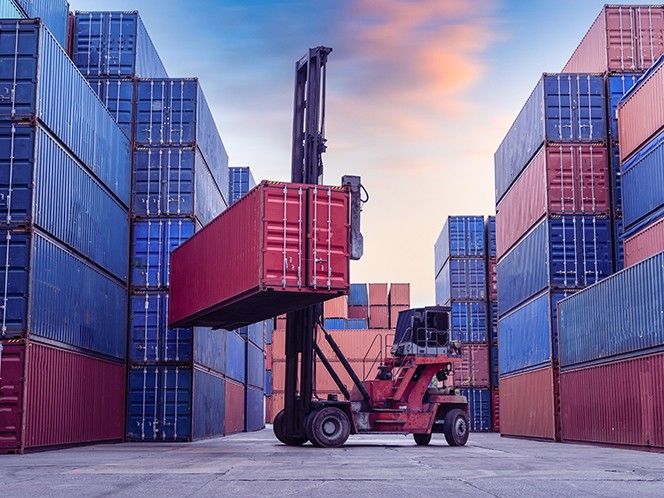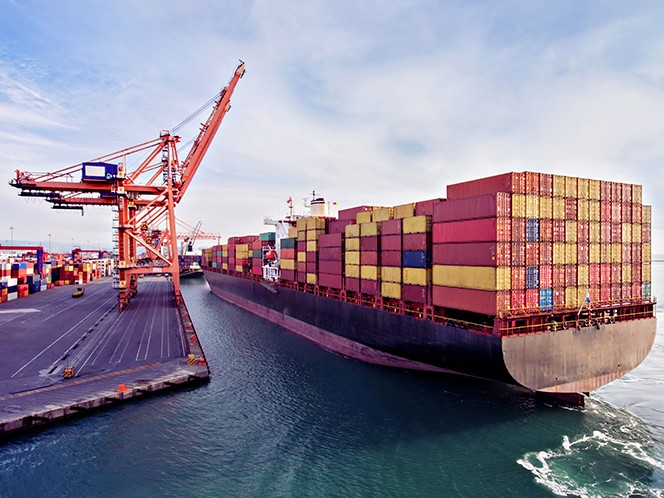Smarter ports for a more resilient supply chain
Posted: July 04, 2025
At the height of the pandemic supply chain crisis, circa January 2022, 109 cargo ships sat at anchor waiting to enter the Ports of Los Angeles and Long Beach, California.[1] The congestion was bad news for many, not least of all the Bangladeshi garment industry.
How’d we get from LA to Bangladesh? Long story short: At home during the pandemic, Americans went on online spending sprees, buying furniture, electronics, exercise gear, and home improvement products, much of it manufactured in Asia.[2] US big box stores, in turn, placed huge orders to keep their inventories stocked. China and other Asian producers ramped up exports accordingly. A dramatic influx of goods, conveyed by cargo vessels, swamped the Ports of Los Angeles and Long Beach, the two busiest container ports in the US, and culminated in January’s massive logjam, which left a legion of 40-foot cargo containers floating off the coast of California and piled at port terminals. In the global shipping system, cargo containers are reused; containers are unloaded at their destinations and returned to exporting countries to be refilled. If an outsize ratio of cargo containers is stranded in California, that leaves exporters elsewhere twiddling their thumbs. Back in Bangladesh, for example, garment makers had goods to ship, but no containers in which to ship them. [3]
The sprawling interconnectedness of the global supply chain is a delicate wonder. A chokepoint here can easily lead to surprising consequences half the world away. To succeed in a world that is at once deeply interconnected and wildly unpredictable, ports must be agile, responsive, and proactive. They must be smart.
From passive waypoint to active participant
Not so long ago, it was common to think of ports as basically passive waypoints. Over the last couple decades, that thinking has evolved for many different reasons:
- a steep rise in global trade, containerization, e-commerce, and just-in-time logistics;
- cargo vessels have become larger while turnarounds have become tighter;
- competition has grown fiercer;
- and the push to decarbonize has grown more urgent.
Meanwhile, alongside all these new challenges, advances in data analytics, automation, IoT, the cloud, and other technologies have presented new solutions and opportunities. Together, these new pressures and technologies have spurred an evolution in how we imagine the port. No longer a mere drop-off and pick-up point, the port of the future is a smart logistical node—a proactive, adaptive participant—in the global supply network. From improving maintenance and automating operations to enhancing sustainability and collaboration, smart ports are reshaping what’s possible.
Real-world examples of smart ports improving resilience
The Port of Portland: Maximizing uptime and throughput with predictive maintenance
When port assets go down, operations go down, cargo is waylaid, and containers start piling up.
By transforming the way we maintain critical port infrastructure—from cranes, gantries, and straddle carriers to cold storage units and power substations—smart ports can improve capacity using the assets they already have.

With digital tools like asset management software and predictive analytics, ports can streamline maintenance workflows, reduce unplanned downtime, and improve throughput across terminals. Predictive and preventive maintenance strategies, built on real-time data, ensure equipment like cranes and dredgers operate more reliably and productively, helping ports handle more volume with less waste, fewer delays, and lower operating costs.
The Port of Portland, for instance, deployed enterprise asset management software to help expedite the 30 tons of cargo that passes through its facilities every year. By redesigning its preventive maintenance program and reducing inventory bloat, the port saved $250,000 in its first year and cut parts stock by over 65%, all while boosting accountability, traceability, and system-wide visibility.
TraPac and Adani Ports: Automating for safer, faster port operations
Automation has been slow to take root in the port landscape, but that’s changing. After all, at first glance, ports seem ripe for automation. Much of port activity is repetitive; the work environment is highly structured. The advantages of the partly or fully automated port are hard to ignore: fewer human-caused disruptions, safer working conditions, and more predictable performance. According to research from McKinsey, automation could help ports reduce operating expenses by as much as 32-55% and improve productivity by 10-35%.[4]
Some forward-thinking pioneers are already proving these benefits. TraPac, which operates container terminals in Los Angeles, Oakland, and Jacksonville, opened the world’s first automated on-dock rail terminal in 2017. The facility uses a mix of electric and hybrid automated straddle carriers and rail-mounted gantry cranes. By combining crane telemetry with data from various control and operational systems and applying custom algorithms to manage equipment routing and scheduling, TraPac has improved cycle times by 10%. Automation has also enhanced customer service, enabling the company to stay within contractual time windows for container unloading.
One of the largest obstacles to automation in port operations is fragmented and siloed data. Without a unified view of operations, it's difficult to orchestrate automation across different systems, assets, and teams. Adani Ports, India’s largest private port operator, found its way beyond these challenges by adopting advanced real-time data management software to centralize and standardize its operations data. With a unified operations center, Adani Ports integrated data from across its ports and terminals, gaining real-time visibility into key performance indicators. This not only streamlined decision-making but also laid a dependable foundation for broader automation initiatives, helping the company improve efficiency, reduce downtime, and better coordinate complex port activities.
Sustainability: Reducing costs and environmental impact
Ports keep the global economy turning, but it comes at a toll to the environment and nearby communities. The shipping industry, of which ports are, of course, a principal player, contributes about 3% of the world’s GHG emissions, along with other air and water pollutants.[5] And, as global trade continues to grow, experts expect port-related emissions will continue to grow as well.[6] Smarter, more efficient ports offer a strategy to curb this growth.
Less efficient operations don’t just increase the severity of supply chain congestion; inefficient operations are less sustainable operations. When delays leave ships, trucks, and cranes to idle and wait, they burn more fuel and produce more emissions; without predictive maintenance, unpredictable asset failures lead to wasted materials and energy; a lack of visibility and coordination lead to misaligned deliveries, delayed pickups, spoiled products, and wasted resources. By avoiding delays, disruptions, and downtime, smart ports demonstrate an essential lesson: Efficiency isn't just a productivity metric—it's a sustainability lever.
Some forward-thinking ports are even investing in solar, wind, marine and other forms renewable energy generation.[7] The Port of Seattle, for example, has installed solar panels atop its facilities, which offset greenhouse gas emissions by about 2.0 to 2.5 metric tons CO2 and are expected to save the port about $10,000 in energy costs annually.
Ports and the energy transition
Aside from operating more sustainability themselves, ports play a critical role in enabling shipping companies to operate more sustainably too. Recently, the International Maritime Organization ratified the IMO Net-zero Framework, which sets a target for global shipping to reach net-zero by 2050.[8] Achieving this goal will require more than just port participation; it will require their leadership.
Under the new framework, large vessels must meet a global fuel standard beginning in 2027. That means vessels will need to improve their fuel efficiency, or switch to more sustainable fuels, like LNG, biofuels, methanol, ammonia, or green hydrogen. But even the most sustainable cargo ships won’t get very far on alternative fuels if ports aren’t equipped with the infrastructure to support them, namely alternative-fuel bunkering stations and storage facilities.[9]
The IMO also encourages ports to provide shore-side power, while the EU’s Alternative Fuels Infrastructure Regulation (AFIR) will make it mandatory by 2030.[10] Shore-side power allows vessels to plug into a port’s electrical grid while moored, instead of relying on onboard diesel generators. However, building and managing this new infrastructure introduces significant complexity. It demands not only greater operational resilience, but also more sophisticated, data-driven approaches to port management.
Cloud-based collaboration: Connecting the port ecosystem
While industries like F&B and manufacturing have begun to connect their supply chain ecosystems via cloud-based data-sharing platforms, adoption in the port ecosystem is still limited and uneven—for now anyway. The potential upside, however, is compelling. Imagine a port where vessels, terminal operators, customs, and inland transport all securely share select real-time data. Ship arrivals align with berth availability; trucks are dispatched only when loads are ready; delays are visible across the chain—less congestion, fewer emissions, and a smarter, more adaptive port.

Ports’ resistance to cloud-based data-sharing is due to a few reasons. As we discussed earlier in regard to automation, the old legacy systems you’ll find at most ports are commonly siloed and not yet cloud-ready. Fragmentation, complexity, and interoperability are also challenges; the port ecosystem is made up of many different layers of organizations, each with their own systems and standards. There are regulatory and legal obstacles as well, and would-be participants have their own familiar concerns about data privacy and control.
Even so, we are seeing early progress toward the connected port ecosystem. The Ports of Rotterdam and Hamburg, for example, share relevant data to help terminals improve resource planning and to help shipping companies direct their vessels more efficiently.
A look ahead
COVID-19 emphasized the fragility of the global supply chain, but it was neither the first disruption to strain our delicate system nor will it be the last. Today, in the spring of 2025, war continues to threaten trade in the Black Sea; rebels still fire on commercial vessels in the Red Sea; an explosion at Iran’s Shahid Rajaee Port has temporarily halted a significant portion of its trade; and rapid shifts in U.S. economic policy are redrawing global trade routes overnight.
In an interconnected world and an unpredictable age, building a resilient global supply chain demands smarter, more agile ports. By embracing technologies like predictive maintenance and cloud-based collaboration, ports can not only withstand future disruptions but also emerge stronger, faster, and greener.
Learn more about AVEVA transportation software solutions
[1] Richardson, B. (2022, November 23). There's no longer a container ship backlog at San Pedro Bay, but challenges remain for the twin ports. Long Beach Business Journal. https://lbbusinessjournal.com/business/news/theres-no-longer-a-container-ship-backlog-at-san-pedro-bay-but-challenges-remain-for-the-twin-ports/
[2] U.S. Census Bureau. (2022, April 27). E-commerce sales surged during the pandemic. https://www.census.gov/library/stories/2022/04/ecommerce-sales-surged-during-pandemic.html
[3] Neil. (2022, January 3). Global shipping container shortage. Prime Freight Logistics. https://www.primefreight.com/global-shipping-container-shortage/
[4] Chu, F., Gailus, S., Liu, L., & Ni, L. (2018, December 4). The future of automated ports. McKinsey & Company. https://www.mckinsey.com/industries/logistics/our-insights/the-future-of-automated-ports
[5] Englert, D., Rojon, I., Salgmann, R., & Sulikova, S. (2023, July 13). A new climate deal for shipping: Three decades to zero. World Bank Blogs. https://blogs.worldbank.org/en/transport/new-climate-deal-shipping-three-decades-zero
[6] U.S. Environmental Protection Agency. (2016, September). National Port Strategy Assessment: Reducing air pollution and greenhouse gases at U.S. ports. https://www.epa.gov/ports-initiative/national-port-strategy-assessment-reducing-air-pollution-and-greenhouse-gases-us
[7] NetZero Events. (n.d.). Can ports serve as renewable energy hubs? https://netzero-events.com/can-ports-serve-as-renewable-energy-hubs/
[8] International Maritime Organization. (2025, April 11). IMO approves net-zero regulations for global shipping. https://www.imo.org/en/MediaCentre/PressBriefings/pages/IMO-approves-netzero-regulations.aspx
[9] Ship & Bunker News Team. (2025, March 20). Ports need green fuel infrastructure overhaul: Danish shipping. Ship & Bunker. https://shipandbunker.com/news/emea/839449-ports-need-green-fuel-infrastructure-overhaul-danish-shipping
[10] European Commission. (n.d.). Alternative fuels infrastructure. https://transport.ec.europa.eu/transport-themes/clean-transport/alternative-fuels-sustainable-mobility-europe/alternative-fuels-infrastructure_en
Related blog posts
Stay in the know: Keep up to date on the latest happenings around the industry.